* (restored/expanded)

‘In his account of the origin of art, Pliny asserts that the history of art begins with the tracing of a shadow. In the apocryphal story, the daughter of Butades, a potter of Sicyon in Corinth, traces her lover’s shadow on the wall soon before he is to depart. The potter then presses clay to the outline to form a relief. Victor Stoichita notes that “[t]he real shadow accompanies the one who is leaving, while his outline, captured once and for all on the wall, immortalizes a presence in the form of an image, captures an instant and makes it last.” The various artistic inscriptions based on the shadow are a marker of the one who has left. In some ways they are more than the person because they persist after the individual is gone; yet, they are also less, lacking expression, detail, or depth. In the experimental films of Janie Geiser, the shadow itself also becomes the space of projection, the space where the imagined other, in the form of a video image, makes its unexpected return.
‘Three of Geiser’s films employ the use of rephotography from a television monitor: The Fourth Watch (2000), Ultima Thule (2002), and Terrace 49 (2004). Each film was shot on 16 mm film, though at key moments during shooting the camera was turned to the television screen. Therefore the rephotographed footage, which is drawn mostly from film history — Disney animated features in Ultima Thule, silent horror films in The Fourth Watch, and television cartoons in Terrace 49 — appears not as film but as video images. They stage an intermedial encounter: the confrontation of film and its video ghosts. As such, Geiser’s rephotography strategy reclaims film for film. Yet, the video intermediary remains, leaving its indelible mark, its medium-specific scar.
‘Geiser’s rephotography films both borrow from and exceed the categories of animation and found-footage filmmaking. Typical of her films, Ultima Thule and Terrace 49 use stop-motion animation strategies, with dolls, wooden figures, toys, and various “found” textures such as wallpaper and scientific diagrams. The heterogeneity of her films is a nod to her involvement in the theater arts and puppetry, where her performances combine a diverse array of elements, including live actors, filmed sequences, and even the occasional glimpse of the puppeteer’s hand. In the three rephotography films, the layering of the found footage elements over the stop-motion animation adds to the density and complexity of the film frame. Beyond the typical concerns of found footage, such as the self-conscious recuperation of film history or the shifting vectors between mainstream and avant-garde cinema, Geiser’s films force film and video into contact with each other as media. When considered alongside found objects, the addition of found footage, or “moving” objects, complicates the status of the animated element. The interplay of filmic layers creates a complex aesthetic of collage, a term borrowed from art history but also used in cinema to describe the collage film or, more generally, the principle of montage.
‘The collagist structures of Geiser’s rephotography films engage critical issues of surface, space, and film history in distinctly hauntological terms, which, following Derrida, constitute an aberrant space, wholly other, infinite and ungraspable. While the found footage films of Bruce Conner, Phil Solomon, and Martin Arnold, which manipulate or resequence their source material, maintain the underlying linearity of the narrative cinema they implicitly critique, Geiser’s gesture is more akin to cubist collage in the way she collapses disparate media within a single frame. In her work, video and film, two distinct systems of representation, are forced into explicit spatial contact. In their uneasy encounter, they contaminate each other, destabilize the integrity of the whole, and produce an elusive, uncanny space that belongs to neither medium. The radicality of Geiser’s gesture, however, is less that it produces an extramedial space, than that it reveals unstable, impure elements already present within each medium. By way of the intermedial encounter, film and video are exposed for the limits of what each may represent and what, in the end, may fall outside the realm of representation altogether.
In Geiser’s rephotography films, the video-generated images act as a kind of “surface-declaring device.” Where collage artists might layer objects and images, a collage filmmaker like Geiser adds to this combination a layering of exposures, collapsing multiple views and temporalities onto a single celluloid plane. While collage bears an implicit connection to montage and film in general, the hermeneutic strategies applied by collage filmmakers are more explicitly aligned with that of their fine-arts counterparts, emphasizing material properties of the medium or critically examining the mass cultural imagery from which their “reality fragments” derive. Yet, even within the milieu of collage filmmakers, Geiser is unique: collage filmmakers typically compose in timed sequences, laying one strip of found footage after another, but her practice is more closely related to the shared spatial terrain of collage artists because of the way she composes a multiplicity of views within a single frame. Depth here refers not only to the three-dimensional representation (or presentation) of an object, after a Bazinian notion of composition-in-depth, but also to the density of an image overlaid with multiple exposures.
‘In this way, the rephotographed video images of Gesier’s films cast peculiar kinds of shadows. Because the 29.97 frames per second of video fit awkwardly into film’s 24 frames per second, the video images appear to roll across the screen. This is most pronounced in The Fourth Watch, where, at any given moment, part of the rephotographed video image is visible while the rest is not. In these blank spaces, different layers are exposed, if only momentarily. The films are thus pervaded by an indeterminancy of image, a vagueness that suggests the surface is not fixed but imbued with its own depth, like a body of water. The presence of video alongside film recapitulates the terms of the image and object in collage; yet, as collage films, Geiser’s work incorporates the added dimension of time and, with it, time’s uncanny surprises. Although the intermedial exchange between film and video foregrounds the flatness of the film screen, the element of time suggests an indeterminate thickness of that surface. Time, too, is a form of depth, compressed in painting but given extended form in cinema, as seen in the temporal disjunction between film and video artifacts. In Geiser’s work, time renders visible another dimension of collage in the juxtaposition of two systems of moving image representation. More than a disjunction in luminosity or color, the most significant gap is that of time: film and video adhere to different rhythms and cannot synchronize. To adopt the eloquent title of Geiser’s 1999 film, the alignment of the two media necessarily results in “lost motion,” pockets of time that point to an unrecoverable beyond. The combination of collage aesthetics and cinematic time in Geiser’s work thus offers more than a flat optic sea; it produces one in which anything can emerge, or be hidden away, at any moment.’ — Genevieve Yue
___
Stills
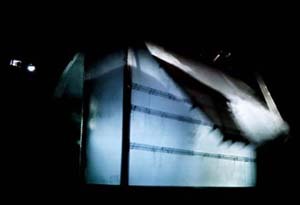
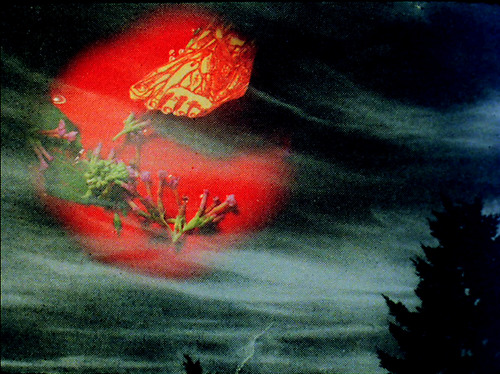



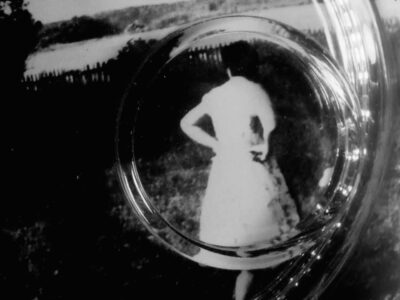


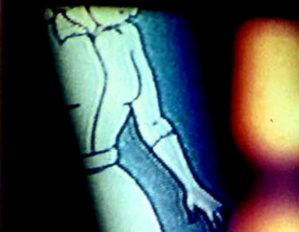
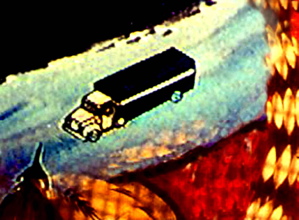




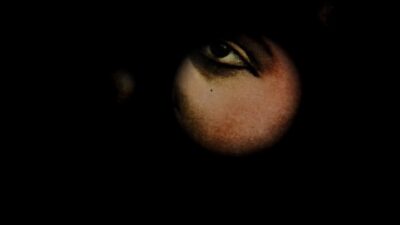




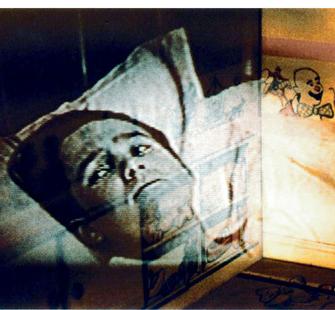
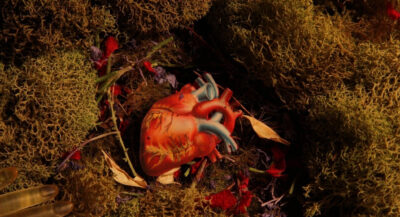





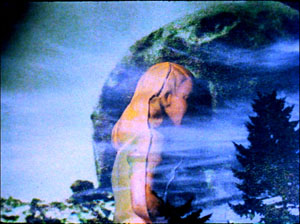

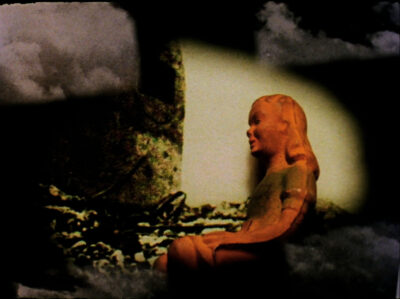





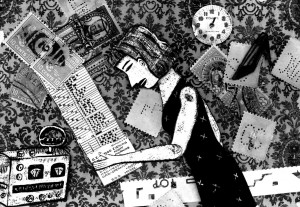








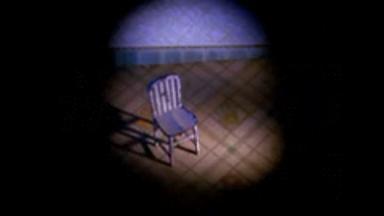








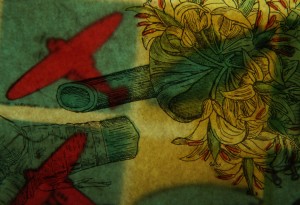







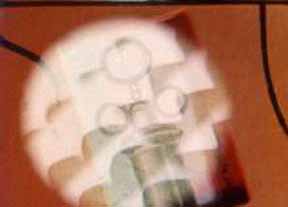


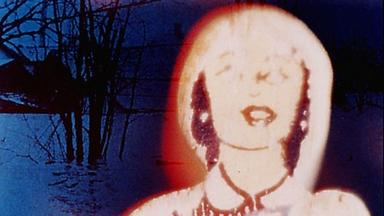


____
Further
Janie Geiser Official Website
Janie Geiser @ IMDb
‘Imitation of Life: Films by Janie Geiser’
‘Experimental Narratives: Janie Geiser’s Evocative Puppetry’
Janie Geiser’s films @ FANDOR
‘Cardboard, Paint, and Style: A Brief Look at the Work of Janie Geiser’
Janie Geiser @ Facebook
‘Miwa Matreyek and Janie Geiser on Collaboration, Wonder and the Importance of Tinkering’
‘Stage Light’
Janie Geiser @ MUBI
‘THE SECRET LIVES OF INANIMATE OBJECTS: THE FILMS OF JANIE GEISER’
‘Janie Geiser Recasts the Cinema of Attractions’
‘Toward a Feminist “Coney Island of the Avant-Garde”‘
‘Five Women Animators Who Shook Up the Industry’
‘The Sharpest Point, Animation at the End of Cinema: Janie Geiser
‘The Intrigue of Animating the Inanimate’
‘Puppet Noir: On Janie Geiser’
_____
Selected Theater
‘In addition to her celebrated films. Jamie Geiser is one of the pioneers of the renaissance of American avant-garde object performance. Geiser creates innovative, hypnotic works that merge puppetry, film/video and performance. Geiser’s performances have toured nationally and internationally, and her films have been screened at museums and festivals around the globe.’ — collaged
FUGITIVE TIME (2014)
‘Conceived/Directed by Janie Geiser, and developed with an ensemble of Los Angeles performers and designers, FUGITIVE TIME is a multidisciplinary performance inspired by the dual histories of illness and health in the early 20th Century.. Promoted as the land of eternal sunshine, LA became a haven (and often final) destination for sufferers of tuberculosis. FUGITIVE TIME merges puppetry, miniature landscapes, film, live-feed video, and music/sound to create an immersive, elliptical meditation on the body, illness, nature, and time. This history was paralleled across the US and Europe, as part of a global Sanitorium movement.’ — JG
Excerpts
Clouded Sulphur (2013)
‘Created in response to the tragic, unsolved murder of a 15 year old Los Angeles girl, Clouded Sulphur (death is a knot undone) navigates a complex terrain of family, loss, revenge, and unexpected hope through a multidisciplinary performance work that merges puppetry, projection, text, and music. Set at the edge of Los Angeles, where the untamed landscape meets the city, the performance centers on absence and the range of feelings that flow through brokenness (revenge, disbelief, unexpected floods of compassion and hope).’ — JG
Excerpt
The Reptile Under the Flowers (2011)
‘The Reptile Under the Flowers is a peepshow/diorama performance in 12 scenes that incorporates puppetry, mechanical performing objects, small projections, music and sound to create a an intimate miniature spectacle. Performed by an ensemble of 15 performers for groups of 8 people at a time, who travel through the diorama-performance. The Reptile Under the Flowers builds its narrative through the accumulation of small actions and events, without text or dialogue, and follows the intersecting lives of a father and son.’ — JG
Excerpts
_____
Interview
from L.A. Record

What was the first puppet you made like?
Janie Geiser: The first puppet—beyond experiments—was actually from college. I was taking a fabric design class, and it was getting back to how fabric was made, like the weaving and things like that—and I’m not prone to that direction. For our final project, it was kind of left open, and since we had been doing a lot of hand stitching, I decided to make a hand stitched puppet. I made it by cutting out an arm, covering it completely in wool embroidery, and then the face, and the eyes, and it ended up kind of looking like a skinny Charles Laughton which wasn’t my intention at all. I was just kind of doing it free form. It was kind of a magical character for me. I liked it. It showed a certain kind of obsessiveness I have—every single bit of it was covered with stitching—so it had a kind of satisfying quality of obsession about it. So I called him Charles Laughton because it reminded me of him.
In a lot of your films, your puppets seem to be flailing about, dealing with all kinds of boundaries and limits. Do you think inanimate objects have emotional lives?
JG: Oh, absolutely! Not that they have them themselves, but we project them onto them. A lot of puppeteers get into, ‘It’s alive!’ and I think we’re bringing it to life through the person performing it and the collaboration with the audience. And it’s because we just bring many powerful associations to objects, and so using that inherent power, that’s already there—it’s kind of like a Rorschach test. You see an inkblot and project into it really emotional things and memories. I think it’s the same thing with objects, and that’s why I’m really into using found objects in my films. The first couple films I made, that were more kind of full films, like the puppet film, and then I made a couple of painted, cut-out films, which I like but started to think they’d all start looking alike if I kept working that way. From the beginning, I was putting objects into them as well, and I got really excited about what they can do, and now I’m always on the lookout for new characters.
Jan Svankmajor said that having puppets when he was a kid was an amazing gift because he could use puppets to play out all life’s injustices, correcting them, taking revenge. Why do you like working with puppets? What do you get out of it?
JG: I don’t know that I’m taking revenge, but I am for myself, trying to get closer to the meanings of things, and hopefully other people are able to find something in that. These ‘Nervous Films,’ they’re about the nervous energy and the world we live in now, how crazy everything is right now. Maybe it’s battling despair. If I’m really paying attention—which I do, unfortunately—to the politics and how things are going everywhere, I would be in despair. I have to have something to do to fight that.
What about the world today are you most nervous about?
JG: A kind of ignorance—not stupidity—but willful ignorance, and a kind of meanness that’s out there, and a greed that’s out there. It’s exemplified in all the budget debates. People would sacrifice everyone who needs help, and they don’t need help because they’re not trying, but because everything in the system is failing them. For political game, people are trying to turn the argument to make those people—it’s the most frustrating thing. You hear people saying things like, ‘50% of Americans don’t pay taxes.’ Well, what that really means is they actually don’t make enough money to pay taxes! It’s characterized as if they’re good for nothing, lazy people—50% of the people in America—and there are new ways that the corporate people are being described as the productive class, the job creators, and all these terms that ignore the greed that’s going on. And I feel despair for the planet. I have a thirteen-year-old son, and I can’t show him that despair. We talk about these things, and I wonder, what is his world going to be like if we keep heading in that direction? But it’s a beautiful day out… ha! We need all these things: food, clothing, shelter, and meaning, and people find it in different ways. I find it through making things. It helps me stay alive and sane—even if what’s in the film is kind of agitated.
The press release says Ghost Algebra suggests one of the original meanings of the word “algebra” is the science of restoring what is missing, the reunion of broken parts. What was missing from your life when you made this film? What has since come back together?
JG: I was actually having a strange health problem, where is sort of where the whole “Nervous” films have come from. I haven’t really ever talked about this, but it’s been a couple years now. I just suddenly started feeling all the electricity in my nerves. It was … unnerving. All those nervous words suddenly became real. It might’ve been caused by something getting pinched, because it did happen right after I had a massage, and I was having a massage because I was so tense. It could’ve been a vitamin deficiency. It could’ve been a combination of things, and they never figured it out. I went to all kinds of doctors, had an MRI, been to a neurologist, and what seemed to help the most was a combination of acupuncture and herbs. But my body was not a familiar vessel anymore.
Would you have preferred to know what the specific problem was, or was not knowing more comfortable? Which would cause most anxiety for you?
JG: I think the not knowing. I never had physical anxiety in my life, and as it went longer, and nobody could tell me what to do to make it better, that’s when anxiety kicked in. So I made Ghost Algebra at the height of not knowing. It’s not about me in that sense—though there are a lot of body parts in there—I was transmitting another kind of nervousness that we have about war. The woman is looking at this old World War I compound by the ocean where they’re hiding and she’s looking into it and seeing the history of sadness and war and killing and bodies. I’m not so interested in being completely autobiographical and confessional because I don’t think my story is that important. I’m more interested in using things that are motivating to me and looking at them in a bigger picture way, but through a very small world.
Your films deal a lot with childhood, with looking back at the past, but seem to suggest that the wholeness of the past is entirely retrievable, because stories are never revealed in their entirety. What’s something experienced as a kid that will always stick with you that you think you remember in its entirety?
JG: It goes to my father. I was not sick very much as a kid, and I come from a big family of six kids, and I was the second child. Looking back as an adult, I feel like part of what I’ve always have longed for is the kind of attention that you get from your parents—I mean they loved us all equally, somehow—but that attention that you get when you’re really little just kept going to the next kid. So I even helped my parents a lot with the next kid as part of that system of love. But when I was about four or five, I got some kind of bad fever. It was like 104. So my parents too me to the hospital, because they had actually lost their first child to some kind of virus. She got a fever and was dead in two days. So they were really sensitive to fever. I was there for a couple of days, and my dad picked me up. He wrapped me in a blanket and lifted me and carried me and I hadn’t been carried in a long time because there were always littler kids to carry and I remember it was an amazing feeling. I still carry my son, probably for that reason. He’s getting too old though.
Nancy Andrews told me that she thinks life and death are always arbitrary—“We think we control such things, or someone controls such things, but it might all me dumb luck or no luck.” What do you think?
JG: I think that’s pretty true. You can stop smoking maybe, but you might just get hit by a car too. There’s murder, there’s war, and those are not random, but maybe it’s random who survives and who doesn’t once you’re in it. I remember my dad my dad telling me about this scar he had. It was at the end of World War II, and a bullet just grazed him. That’s pretty random. That’s luck. Some kid gets shot in a drive-by—that’s terrible luck. Often they have nothing to do with it. They just were there at the wrong time. Drunk drivers. There’s some control with personal behaviors you have, but it’s usually the other person’s personal behavior that unduly effects you. We’re all going to die—it’s nothing profound to say that—but we push it. I found this book at the Last Bookstore downtown, and I haven’t read it yet, but it’s The Denial of Death. I do think we just live because we don’t want to think about the other option. That was the thing with the nerve problem. I just thought, ‘I really don’t want to die right now. At least til my son is twenty to die.’ I don’t want him to be one of those kids whose mother dies when they’re thirteen.
___________
16 of Janie Geiser’s 20 films
_____________
The Red Book (1994)
‘The Red Book is an elliptical, pictographic animated film that uses flat, painted figures and collage elements in both two and three dimensional settings to explore the realms of memory, language, and identity from the point of view of a woman amnesiac. The Red Book suggests the ways in which language defines us, and reaches back into dismemberment myths about the creation of different tongues through the breaking apart of bodies (in this case, the woman’s body). As the film progresses, the submerged images of her stored memory appear and collide with the present world in circular rhythms, and there is a sense of irretrievable loss.’ — JG
the entire film
____________
Lost Motion (1999)
‘Lost Motion uses small cast metal figures, toy trains, decayed skyscrapers, and other found objects to follow a mans search for a mysterious woman. From an illegible note found on a dollhouse bed, through impossible landscapes, the man waits for her train which never arrives. His wanderings lead him to the other side of the tracks, a forgotten landscape of derelict erector- set buildings populated by lost souls. Dream merges with nightmare in this post-industrial land of vivid night.’ — Freewaves
the entire film
___________
Spiral Vessel (2000)
‘A found psychological test kit yields puzzle figures with cutout ears, cutoff heads, and pullaway body parts. The ear opens into an interior world of shifting science book images which, when isolated, evoke mysteries more than they reveal facts.’ — JG
Excerpt
____________
The Spider’s Wheels (2006)
‘Geiser was inspired by the heroines in early film serials, known as the “serial queens,” along with the display of heightened feminine power in film throughout history and how they are reflected in political and cultural movements. The Spider’s Wheels is a cinematic diorama-installation combining projection, sculpture, and film. The piece is centered on the star of a fictitious serial about a female detective known as “The Spider.” Found footage of a contemporary actress playing a silent film star heroine is projected throughout the different areas of the installation. The projection areas include sculptural areas such as a Plexiglas box with metal flaps that serves as a silver screen, a wire mesh screen resembling a web that rises and falls in a three-minute cycle while the footage is projected onto it, and a staircase that leads to a door where the viewer must look through a peephole in order to view the scene.’ — collaged
Documentation
_____________
Ghost Algebra (2010)
‘Geiser’s ‘algebra’ theme seems to peek through at times in images of severed limbs or broken bones, teeth, spilled blood, and of course the various number machines that pop up. The word algebra apparently used to have a meaning related to restoration or reunion, sometimes applying to the setting of broken bones which was often done in medieval times by a dentist who also performed bloodlettings. Interesting. But this film is not really about mathematics. At least not the usual kind. It’s about piecing together a vision of the world. Immersion.’ — Candlelight Stories
the entire film
____________
Kindness Villain (2010)
‘In Kindless Villain, two boys wander through a stone fortress, while the history of never-ending battle forms traces in the waters below. Seemingly alone in their island world, the boys succumb to fatigue, and to rituals of power. Scratched phrases from an ancient recording of Hamlet reveal a sad cry for vengeance. War is a child’s game, played quietly in this forgotten world.’ — JG
Excerpt
____________
The Floor of the World (2011)
‘The title comes from a phrase in a book by Mozambican author Mia Coute: “The floor of the world is the ceiling of the world below.” Collage images and objects are use to suggest narratives of burying, uncovering, building, destroying, longing, and loss. The sound collage uses vinyl recordings, including a 1940’s radio play of Frankenstein, as well as recorded live sounds. Premiered at 2010 NY Film Festival.’ — JG
Excerpt
_____________
RICKY (2011)
‘The realms of childhood, war, and loss echo through Ricky. A found sound recording forms the spine of the film…an scratched audio letter from father to son.’ — JG
Excerpts
_____________
Arbor (2012)
‘From a set of photographs found in a thrift store, Geiser creates a liminal space between representation and abstraction, figure and landscape, fiction and memory. ARBOR suggests the fragility and ephemerality of memory and its artifacts through subtle manipulations of the photographs: reframings, layerings, inversions, and the introduction of natural elements, including flowers and leaves. The photographs’ subjects rarely engage the camera; they are glimpsed, rather than seen. They look elsewhere, and wait for something inevitable. Gathering on a hillside, lounging on the grass beyond now-lost trees, the inhabitants of ARBOR cycle through their one elusive afternoon, gradually succumbing to time or dissolving into landscape, reserving for themselves what we can’t know—and becoming shadows in their own stories.’ — JG
Excerpt
______________
The Hummingbird Wars (2014)
‘A collage film, collapsing time and place: turn-of-the-last-century performers apply stage makeup as if for war, to engage in battle for the soul of the world. The injuries are more emotional than physical, but cut deeply just the same. A visual/aural collage film, drawing on sources as seemingly disparate as Ibsen’s A Doll House, Japanese Gagaku music, makeup illustrations for 19th Century actors, the biography of a Shakespearean performer, blooming and decaying flowers, and a World War 1 First Aid Book, The Hummingbird Wars suggests theater in a time of war, which is the theater of any time.’ — JG
Excerpts
_______________
Look and Learn (2017)
‘Look and Learn excavates the visual vocabulary we use to operate and construct our daily world. Look and Learn explores the juxtaposition of two material image forms: instructions (furniture assembly diagrams, how-to manuals, safety instructions, maps) and photographs—here mainly 1950’s era school class photographs and images from photography manuals. The instructions fight for time with the school photographs, the kind that place a group of individual students into an unforgiving grid. The school photographs suggest a more orderly time, when the instructions might actually be followed. The photographs themselves become another kind of diagram, forming barely glimpsed guides to the students’ future world. They look ahead, to the 60’s and 70’s, when the imagined order of things will be exploded.’ — JG
Excerpts
______________
Fluorescent Girl (2018)
‘Fluorescent light reflects on a girl’s image, while looking at book of photographs by Paul Strand in a New Hampshire bookstore.’ — JG
Excerpt
______________
Valeria Street (2018)
‘The starting point for VALERIA STREET was a frayed Kodak box of 7 slides that fell off a shelf of collage materials in my studio. Curious, I put them on a light box. The slides depicted a group of 5 men, staged around a conference table in a generic office setting, curtains closed. The men were looking down at a set of drawings or documents. At the center of the frame, in the middle of the table, was one man. He held a pen in his left hand. When I looked through the camera lens, I saw that this man in the center was my father. I had no memory of when these slides came into my possession. They must been in some boxes of ephemera that I saved when my father died twenty years ago. The photographs were awkward and artificial—staged documentation or re-creation of some kind of presentation/signing of documents. My father was a chemical engineer with a large petro-chemical company. The situation at the table is a familiar one of male power—a group of men gathered to make decisions. The men were arranged around the documents like the disciples in The Last Supper, or the guild members in Rembrandt’s painting “Syndics of the Drapers’ Guild”, or numerous iconic photographs of presidential cabinets, boards of directors, or chambers of commerce.’ — JG
Excerpts
______________
Reverse Shadow (2019)
‘I do not claim to fully understand the complexity of Janie’s work, but there’s a particular intuition that is paramount when approaching it, as with any great work of art. Reverse Shadow is the latest product of Janie’s genius, and it’s the result of her endless imagination which has give birth to dozens of films, installations, puppet shows, performances and a vast mixture of all the former.’ — Jose Sarmiento Hinojosa
Excerpts
______________
22 Light-years (2021)
‘22 Light-years draws on a range of visual sources, including photographic negatives, diagrams, found patterned papers, and archival footage. These sources merge, sometimes uncomfortably, with video that was screen-recorded while operating desktop home design software. By creating digital floor plans, landscaping, and roofless homes in real time, and manipulating those videos to move them further away from the software’s intent, Geiser fabricates a digitally lush, elliptical, uncanny world, where home planning never results in a tangible home. The familiar material elements (negatives, diagrams, flower seed packets) wear the skin of the immaterial realm, suggesting time as simultaneous, mutable, and unknown.’ — JG
Excerpts
______________
Chameleon Law (2022)
‘A few years ago, I was given a set of faded vintage 35mm slides by a neighbor. Recently, during this pandemic, I finally found the time to look at them. Most of the slides had taken on red or pink hues, evidence of time and change, the loss of blue and yellow pigments. These vermillion hues gave the slides’ subjects –mountain landscapes, long-span bridges, tourist sites—a simultaneously sublime and corrosive appearance. In Chameleon Law, the time-altered images, alternately depleted and extreme, suggest a heated landscape of the past and future. The title of the film comes from a concept articulated in the allegorical / surrealist novel Mt. Analogue. Chameleon law rocks us asleep and prevents us from seeing the other 99% of the possibilities that are at hand in each situation. With conventional ‘common sense’ we easily fall prey to the chameleon law. Like the witnesses in the film, we have a choice to see beyond what we know, to avoid falling prey to chameleon law, as the landscapes of the world fade to red.’ — JG
Excerpts
*
p.s. Hey. ** Jack Skelley, Jack! Fancy that! One day you simply must do a post about electric Miles. That’s almost an order. Thanks, bud. Keep it loving, Dennis. ** Anon, Greetings, mysterious one. The only Radiohead I really liked was ‘OK Computer’. Other than that, not so much. But point me at something to try. Thank you, let’s learn from each other. Hm, on your question … It depends on whether you can honestly see the editor’s point. Like, if you can reach a state of objectivity and see a way whereby de-weirding (in the editor’s terms) your work could enhance it in some way without losing the essence of what makes your work yours and special and original. I mean if de-weirding it would merely clean the work of unnecessary filigree. Does that make sense? For instance, when I submitted my first novel ‘Closer’ to Grove Press, the editor said they would publish it if I revised the first chapter, which he thought was too dense and overly artful to ease the reader into the novel properly. I thought about it, and I decided he was right even though I’d pretty carefully planned the novel to start that way for what I thought were very good reasons. But, really, you need to protect what it is about your work that is essential to what you want to do. It’s a dilemma. What are you thinking you’ll do? I’m very curious to know. Thanks for sharing that and for the high five. Love and a lustrously unfolding Monday to you. ** Cori, Hi, Cori. Yeah, my blog can be weirdly persnickety re: comments sometimes, and I’ve never been able to figure out how to fix that. Cool about the workshop. Good old BB. I’ll look into Jose Hernandez Diaz’s work, I don’t know it. Oh, yes, I actually blurbed the first edition of Siken’s ‘Crush’. I like it a lot. I don’t think I’ve read ‘War of the Foxes’. I’m ‘friends’ with him on Facebook, and he’s doing these very strange AI generated visual pieces these days that he’s sharing there, very odd, haunting. La Brea, cool. Big congrats on the novel and the play! Wow. What are you doing to get them to the public? I look forward to reading/seeing them in the hopefully near future. Cool, you’re doing great. Tell me more. Thanks! ** Dominik, Hi!!! My weekend was some last-ish film work stuff. Uh, I watched a terrible old disaster movie called ‘Avalanche’ starring Rock Hudson and Mia Farrow, but I like every disaster movie, even the seriously not good ones. Not much else. Some writing. Please tell love I appreciate the warning not to try to watch ‘He Went That Way’ for the first time. Love telling me what time of day I could go to Krispy Kreme without having to wait in line for over an hour to buy one donut, G. ** video_video, Hi, vv. Very nice to meet you. That’s a great clip of ‘7 and 7 is’. I’ve never seen that incarnation of Love before, and I’m a pretty hardcore fan. Curious. If you haven’t seen it, this is a really good clip of the second generation (‘Four Sail’ era) Love playing ‘August’ live in Copenhagen in 1970. Thanks for the share! Have a great one! ** Charalampos, Good start on the poetry books accruing. Glad you’re working on your work and seemingly excited about that. ** _Black_Acrylic, Hey. Oh, I could restore your Acid House post, yes, and I will do that. Watch this space. Whoop re: Leeds United! Hot times in your neck. ** Bill, Hi. Are you a yearly victim of the Santa Ana Winds? Wait, I don’t think they have them up there where you are. They’re the desert’s punishment. Man, they’re tough. Oh, wow, fascinating: The Dorothea Tanning show. Very nice. I really need to go out and see art. This week. ** Steve, Thank you again, Steve. Oh, man, surely your doc has gotten back to you today. I’m so sorry, pal. ** Growl, Hi. Weekend was okay. Oh, uh, too long and boring and complicated to explain the stressful Friday. Film stuff. Nothing entirely new. Yikes, that mayor, that town. Wow. Glad it was one-day-er only at least. ** Darbyyyy 🐒🐒, Did you manage to conk out pre-11? As an early morning person, I do kind of miss sleeping until noon. Not that I ever did. Nowadays when I wake up at 6:45 am, I feel like a lazy ass. Did your cat’s neck fit inside said collar without consequent suffocation, I sure hope? Not a bad plushie right there indeed. It must have an interesting back story or lineage or something. ** Uday, Hi, U! Thanks for digging Steve’s thing obviously. This week? Today there’s some last film stuff to do pre-submission. If that goes smoothly, then I’d like to see some friends I haven’t seen in yonks due to film consumption. Maybe see a movie or two. Work on some fiction. Further bat ideas around with Zac about our next film. Eat a pizza. And Mexican food. Stuff like that. Wait, your queer organisation could take over the frat house? That would be amazing. What happened at the meeting? The suspended frat boys will freak out, won’t they? Luck today! ** Corey Heiferman, Hi, Corey. I only just remembered there’s this big contemporary art world figure in LA named Marvin Heiferman. But that’s probably a common-ish name? Cool guy. I’ll look for the Chris Tonelli book, thanks. Big trip plans there, very nice. Paris should be plenty splendid in late April, albeit a little rainy maybe, but it’s always a little rainy here. Cool. Hit me up me with the deets, obviously. And do link me to your weekly newsletter/blog thing when it’s realised. Very nice. Big day and week to you, sir. ** Okay. I decided to restore and update/expand an old blog post about the wondrous animated filmmaker Janie Geiser today, and I hope it hits your spots. See you tomorrow.




 Now available in North America
Now available in North America 
Hey Dennis,
I think Radiohead have so many great albums. In Rainbows (lush and romantic) and Kid A (disturbing and dreamlike) are favourites of mine.
Re: editors, I think you’re right. The answer to the question is always specific to the work. Luckily I am not under pressure to hand something in, so I can take my time and just focus on writing. My plan is just to write and build up confidence in what I’m trying to do, and be able to articulate what it is as best I can, before I go back to this editor.
I just wanted to run it by you. Thanks for sharing your experience. You confirmed what I was thinking. There’s no hard and fast rule. It’s all about understanding your own vision.
Much love, Me
Dennis, Bernard’s always rescuing everyone, no? 😀 In the last novel I wrote, I give a shout out to Tim Dlugos. No way I couldn’t.
Well, I did see Dune 2 and Timothee was actually great in it. Really subtle performance in which he goes from reluctant hero to a bit of a madman full of his own myth. One thing that’s bugged me about him is that he’s seemed to have developed these go-to expressions and stuff. None of that here. All little subtle things he does. He really was good. And the movie was good, much better than the first. Nothing lacking this time.
I go into these with not-high expectations. I’m not expecting high art. I’m looking at them within their genres. And this one was really good. David loved it and even said after, “Timothee IS a really good actor. I didn’t realize how good he is.”
Even Alex liked it, though I pretty much dragged him to it, haha. We had a great evening. A good dinner afterward and Alex was here until 4:30 (Daylight Saving Time, ya know).
Hope your weekend was swell.
Hi!!
“Avalanche” sounds so familiar. I might’ve seen it, too. Yeah, disaster movies have a certain charm, even the really bad ones. So do, at least to me, some borderline unwatchable reality shows. For example, I have an inexplicable soft spot for “strong people” shows.
Looks like the initial wariness about Krispy Kreme disappeared pretty spectacularly… Love explaining to me why I have to pay “television tax” in Austria if I don’t have a television, Od.
Janie Geiser is a new name to me and I enjoyed this peek at her work a lot. It puts me in mind of a very fondly remembered 80s UK kids show called Bagpuss. Her stuff seems to share some of its uncanny charms.
Today I sent away the latest episode of Play Therapy v2.0, due to be broadcast this coming Sunday. Not wanting to hype it up too much, but I feel this is another good one.
I’ve been in touch with my doctor’s office, but the situation is not yet resolved. I hope we can get somewhere by the end of the workday today, but my anxiety is back up after a brief respite.
I have two recent album reviews, on Gouge Away’s DEEP SAGE (https://www.slantmagazine.com/music/gouge-away-deep-sage-album-review/) and Kim Gordon’s THE COLLECTIVE (https://artsfuse.org/288458/rock-album-review-kim-gordons-the-collective-ensnared-in-anxieties/)
Did you watch any of the Oscar ceremony last night?
I enjoyed Ann Turner’s 1996 DEVIL DOLL, which I saw yesterday. It stars Sandra Bernhard in a takeoff of TEOREMA set in the suburbs of Sydney, except that instead of “liberating” the family, she represents American capitalism, sleeping with them to convince them to sell their land. It has a darkly comic tone akin to a lot of ’80s American indie films.
Hi Dennis
I’m so glad you enjoyed the video! To hear that song, then watch it practically bursting out from Arthur Lee, I mean it’s divine. Oop-ip-ip oop-ip-ip yeah! I also loved (ha!) the video you shared of August, especially watching George Suranovich on those drums. Must be hard to rub your stomach, pat your head, and jump all at once. And make it sound good too! If you ever need any other internet sleuthing, I like a good quest and lots of alone time. I wanted to ask, kind of random but since today is a lovely film day why not, if you’ve ever seen the movie August Underground, and if yes, if you have any opinions on it?
I look forward to watching all the clips you’ve shared today and it’s good to meet you too! 🙂
Hi, Dennis! Love this post on Janie Geiser, and the general diversity in your posts in general. I’ve never seen any of her stuff but I will make it a point to. On the topic of experimental film, I’ve been meaning to check out the LA Film Forum but they haven’t shown anything that really caught my eye yet. Since moving here, I’ve checked out New Bev, Vista, Los Feliz, and Vidiots. All great theaters. Just recently saw both ‘Blonde Death’ and ‘LA Plays Itself’ for the first time, have you seen those?
I’m in a bit of a strange place with both the novel and the play in the sense that I’m not super sure which route to go. A lot of places won’t read either without an agent, which I don’t have. An editor at the Dial Press was reading my novel for a while, but I had a feeling she wasn’t going to take it as I think it’s a lot stranger than what they usually published. A lot of people tell me not to rush getting an agent because then I have to pay them a percentage of my earnings, which I suppose is true, but I worry about making a shoddy deal somewhere without really knowing what I’m doing. If you have any tips, I’d love to hear them! Thanks again!
Not a day goes by when I don’t think of you at some point Dennis… and it’s a welcome invasion… today I imagined bumping into you as I did my run… hurling a string of profanities at those I pass… and passing sarcastic comments.. exagerating yawns at people.. etc… I spat in the direction of the MI6 building three times from across the way earlier… + there’s a statue of a mother +father holding a baby up opposite the ‘worlds end’ estate… I sometimes pretend to shoot it… as i hate it… it’s around there that I often imagine seeing you actually… + I stop and say hi…
X
oooh!
I did actually get in bed before 11! But falling asleep is a different question.
I got the cat collar today I’ll let you know when I see her if it fits.
I don’t really much to say or whatever about today. It was just a day. I did wake up early.
I have court this Wednesday which could be why everything is so strange. Its so stupid but oh well, I though it was supposdbeglnlknlk
nvm.
Goodnight.
Oh, have you ever been to the Caribbean? OR anywhere tropical where they harvest sugarcane?
AHHH quick blow sleep dust on me or idk throw me down a K-hole
I CANT SLEEP. I must be feeling antsy, oh well cant sleep now its to late or early.
Why is Tchaikovsky so dramatic? I don’t know he is good though.
Well good morning I guess.
https://www.youtube.com/watch?v=ZyoatfzxQ9s
My morning soundrtack
See you friday!! (reasons…)
Hey Darby, word on the street is that Tchaikovsky was dramatic because he was seriously closeted. Good luck getting to sleep I know the struggle.
Hi, Dennis! Hope you had a lovely weekend. Thanks for the introduction to Janie Geiser. A new name for me. Just finished watching Wim Wender’s ‘Perfect Days’. A very simple, but very effective film. The range of emotions it evokes is a wonder. Have you seen it? If not, I recommend. 🤗
The meeting went well so let’s see. Our biggest obstacle is admin wanting to use the house for storage space. Not to be cocky but I feel fairly confident in my persuasive abilities+ am surprisingly well liked by frat boys so other student organisations should hopefully not pose a problem. It’s amazing that you’re going straight to another film. I’m sure people say it all the time and I think I’ve said it before but you’re proper cool. Have you ever been anywhere in South/Southeast Asia?
As with all of your experimental film posts this looks great and I’m bookmarking it for the rooftop cinema. That L.A. Record interviewer went for the jugular. Is that their house style or one particular angsty journalist?
Corey Heiferman is an alias. In real life Corey is my middle name that I don’t use much and Heiferman was my great-grandfather’s name in Hungary that my grandfather changed to something more Anglo-Saxon in America. I have no known Heiferman relatives. My only family connection to fame is a distant cousin who married Eli Wallach.
I’m curious what the Temenos team is going to do. I suspect that demand for spots is much higher than supply.
Apropos Paris I’m finding accommodations now and will also order tickets to popular museums in advance. Other than that I guess I’ll look for events that might sell out and order those tickets in advance too. In general though I’m a spontaneous traveler. Do you have any recommendations? I thought about possibly arranging a private film screening at Light Cone if it’s not too expensive. Do you know anyone who’s done that?